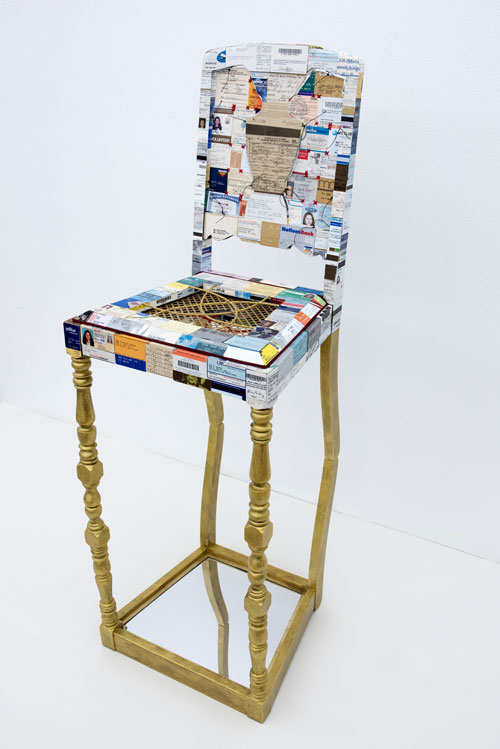Your cart is currently empty!
Kim Abeles

Kim Abeles’ aptly named “Portraits and Autobiographies,” which explores the boundaries between photographer and subject with intimate self-portraits and sculptures, features silver print photographs produced from 1979 to 1983 along with assemblage and digital prints that grapple with the concept of identity. The collection engages in the feminist discourse that typifies Abeles’ work, as her photos contravene patriarchal notions of women’s roles.
A sense of confrontation is elucidated through images of discord, with Experiment for Myself as Other (yardstick) (broom) (tree branch) (metal rod) (1979), which records Abeles activating the camera’s shutter release with various objects while gazing into the lens. The title suggests that the images are a reconnaissance into the psyche of what a photographic subject may feel upon being photographed. Abeles appears to ward off the camera with these objects as if both the camera and the object releasing the shutter are weapons while the camera seems to invade her personal space, creating tension between camera and subject. This collection contrasts the transparency of Abeles’ personal identity in the other exhibited pieces and mirrors the invasion of personal space women encounter.
A feminist tone can be intuited throughout Abeles work, especially in the video Ironing all the paper trash from Earth Day at the California Science Center (2010), which shows Abeles continuously ironing wrinkled papers and transferring them from one wastebasket into another. The video demonstrates the tedium of “women’s work” and stands in direct contrast to the human-camera cyborg photographs Sisyphisto (1983), a self-portrait of Abeles carrying a 100 pounds of her studio equipment, and Self Portrait (1990), which shows a variety of cameras affixed to Abeles’ face. These self-portraits along with Our Position Always Reciprocal (ankle) (face) (1982) display a transformative merger of photographer and camera and ratify a dedication to photography rather than traditional “women’s work” like ironing.

One particularly refreshing facet of the exhibition is its nuanced humor and sarcasm. The photographs of Abeles struggling to overcome massive piles of paperwork appear like something from a Terry Gilliam fever dream, offering insight into frustrations related to the paper trail of the modern human, and moreover the modern woman. Humorous undertones are evident, especially in Self-portrait with Files (tower) (1995), an image of Abeles slumped over a giant tower of articles and critiques in what is clearly an “I give up” moment. Other works like Self-portrait as a rock (2015) and Self-portrait dyeing my wedding dress black (1993) reveal Abeles’ ability to not take herself too seriously.
While the various self-portraits explore the artist’s personal identity, Self –portrait (Pope Joan) (2015)—a modified chair covered in a collection of Abeles’ identification cards that she’s had since 1952—does this to the greatest extent. In this display of the numerous aspects of herself, whether it’s an expired ID or SFMTA card, Abeles adopts vulnerability as strength. She demands to be seen honestly, and by doing so rises above criticism of sentimentality into a space where no weaknesses can be revealed about her, as she’s already done the work herself.